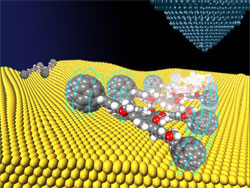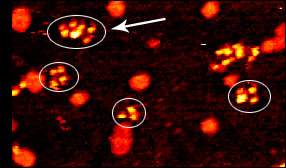Thrawn Rickle 93How About those Little Cars© 2005 Williscroft |
| One of the recurrent themes in the “classic” science fiction from the so-called Golden Age of the 1950s is miniaturization – shrinking a machine so small that it and its occupants experience the sub-microscopic universe as if it were another universe like ours, but at a different scale.
A good example is Isaac Asimov’s Fantastic Voyage. In this novelization of Jerome Bixby’s original story that was adapted for film by David Duncan, Asimov’s heroes and their small submarine are shrunk until they can be injected into a human patient where they cruise around, encountering the body’s defense mechanisms that perceive the miniaturized sub and its passengers as an invading organism, and finally save the patient’s life. Richard Matheson’s Incredible Shrinking Man is another fine example from this genre. Hero Scott Carey discovers that he is shrinking (for reasons that don’t matter here), encountering perils on his smallward journey. Finally, he emerges into another ultraminiature universe that mirrors our own. It’s great stuff, and Fantastic Voyage and Incredible Shrinking Man made exciting movies, but they and all their kind have a fundamental flaw: Quantum physics. That’s right – Max Planck and his buddies discovered back in the 1920s that the universe contains absolute limits. Planck wasn’t very happy with the results, but they determined that the very concept of predictability disappears at the very very small end of the spectrum. For example, you can determine the precise location of a very small object (such as an electron), but you have no idea when it was at that spot. Your best bet is to find a compromise that gives you a reasonably close approximation of its location within a time window that works for you. Planck didn’t like this at all, and Albert Einstein commented about the uncertainty contained in the new physics that “The Old One [God] doesn’t roll dice.” Things continued much the same until – in 1977 – an MIT undergrad named K. Eric Drexler burst into scientific consciousness. He envisioned a swarm of very tiny robots that could build essentially anything at all, atom by atom or molecule by molecule. Fill a black box with these “molecular assemblers,” add a supply of inexpensive chemicals, and out would come gasoline, rubies, space ships, floor wax…without significant cost or labor. In the human body (shades of Asimov), nanomachines could repair bone and tissue and cure disease. Released into the environment, nanomachines could clean the Planet’s air and water. This was innovative stuff – and way more exciting than anything else on the scientific horizon. An entire generation of nerds began grappling with this new “nano” concept. In the fourteen years between 1977 and 1991, when MIT finally awarded him the first ever PhD in Molecular Nanotechnology, Drexler published some twenty technical and research papers including the landmark paper, “Molecular engineering: An approach to the development of general capabilities for molecular manipulation” in the Proceedings of the National Academy of Sciences (1981), six books including his thesis and in his popular 1986 book, Engines of Creation: The Coming Era of Nanotechnology, his more technical book in 1991, Unbounding the Future: The Nanotechnology Revolution, and three patents including one in 1986 for the Solar Sail – an innovative way to propel space craft throughout the solar system. One of Drexler’s early admirers was Richard F. Smalley, a chemist at Rice University. Smalley shared the Nobel Prize in 1996 (with Robert F. Curl, Jr. and Sir Harry W. Kroto) as the co-inventor of Buckminsterfullerene, a soccer ball-shaped group of carbon molecules popularly known as Buckyballs. In the Summer of 2005, Smalley told Ed Regis (the author of Nano: The Emerging Science of Nanotechnology) that “[In the early 1990s] I was enchanted by Engines of Creation. I read it in a single sitting, and then I reread it.” In 1999, Smalley testified to Congress about “what will be possible when we learn to build things at the ultimate level of control, one atom at a time.” With time, however, Smalley came to believe that Drexler’s concept was scientifically impossible. Drexler had warned that nanotechnology could be misused with disastrous consequences for humankind – brought into sharp focus by Michael Crichton’s best-selling book, Prey, wherein a lab accidentally releases a nanoparticle swarm. The particles eventually sweep across the Nevada desert causing havoc and mayhem, with the potential for destroying all life on Earth. In May 2003, the House of Representatives passed (by a 405 to 19 vote) the Nanotechnology Research and Development Act for which Drexler had lobbied long and hard for several years. Before the bill got to the Senate in November, however, Smalley and friends stepped up to the plate. Drexler had always been the nerd’s nerd, socially inept, and politically naïve. Smalley, on the other hand, was the paragon of scientific sophistication – a smooth-talking, hand-shaking, political veteran. Smalley accused Drexler of deliberate fear mongering and worse, telling congress that his ideas were pure fantasy. A coalition called the NanoBusiness Alliance added the horsepower of venture capitalist F. Mark Modzelewski, long-time opponent of Drexler, who quipped that Drexler’s ideas were like “a wino’s claims on skid row that bugs are crawling under his skin.” Faced with this kind of high-powered opposition, unable to get any meaningful support from politically inept Drexler, and having to deflect a growing public perception that nanotechnology was dangerous, thanks to Crichton’s popular novel, House and Senate staffers finally pulled all the funding provisions for development of Drexler’s molecular assemblers out of the compromise bill. President Bush, with a smiling Smalley at his side, signed a bill that virtually ignored Drexler’s ideas in favor of more mundane but “attainable” goals. It was no contest. When the dust cleared, Drexler found himself alone, outside the scientific mainstream of the very discipline he had invented. But it wasn’t over by a long shot. Somebody forgot to tell the grass roots researchers that their goal was impossible. Since they had no idea that what they wanted to do was scientifically impossible, they kept right on trecking. Smalley’s old stomping ground, Rice University, was at the center of this hotbed of scientifically untenable activity. For eight years commencing back in 1997, Prof. James M. Tour lead a research team consisting of Kevin F. Kelly and graduate students Yasuhiro Shirai, Andrew J. Osgood, and Yuming Zhao. Since Smalley neglected to tell these guys that they couldn’t get there from here – guess what? They did just that. On September 26, 2005, they published their results in the American Chemical Society’s Nano Letters. They titled their article, “Directional Control in Thermally Driven Single-Molecule Nanocars,” and there is no doubt that they have created something that was considered completely impossible by Smalley and colleagues just a few months ago.
These are very tiny vehicles, four nanometers long and three wide – 20,000 would fit side-by-side on a human hair. The wheels consist of 60-atom carbon Buckyballs that really roll across a landscape of pure gold. Each axel on the car and truck, and all three on the trimmer pivot independently so the vehicles can negotiate around, over, or through atom-sized potholes and mounds on the gold surface. According to Tour, these single-molecule vehicles cannot be made any smaller. We’ve reached the quantum limit defined by Planck and colleagues nearly a century ago. The nanocars simply go from here to there. The nanotrucks can carry a small molecule from here to there, and deposit it upon arrival. The trimmer can get there even if the surface isn’t perfectly smooth, and it can carry a payload. This is exactly what Smalley said was scientifically impossible – the controllable transport of individual molecules to specific sites where they can be deposited in a controlled way to meet specific construction/manufacturing goals. Tour says that we still are a long way from economically useful applications of this development. Nevertheless, the initial hurdle is behind us now. I think Tour is being way too conservative in his estimate of how fast things will progress. A few short years following Smalley’s discovery and development of nanotubes and Buckyballs, entire industries are dependent on these erstwhile scientific curiosities. Lasers once occupied the isn’t-this-cool-corner of sciences’ curiosity shop, but the world we know today would be entirely impossible without the ubiquitous laser. I suspect that real economic uses for nanocars and trucks will surge in a similar manner, until we will experience nanovehicle traffic jams worse than on the Los Angeles freeways on Friday afternoons. Oh yeah – there has been at least one recorded collision already:
So, how about those little cars. Prof. Smalley – you’d better get out of the way. |
 James M. Tour’s Nanocar & Nanotruck
James M. Tour’s Nanocar & Nanotruck James M. Tour’s Nanotrimmer
James M. Tour’s Nanotrimmer Nanotruck collision – indicated by arrow
Nanotruck collision – indicated by arrow